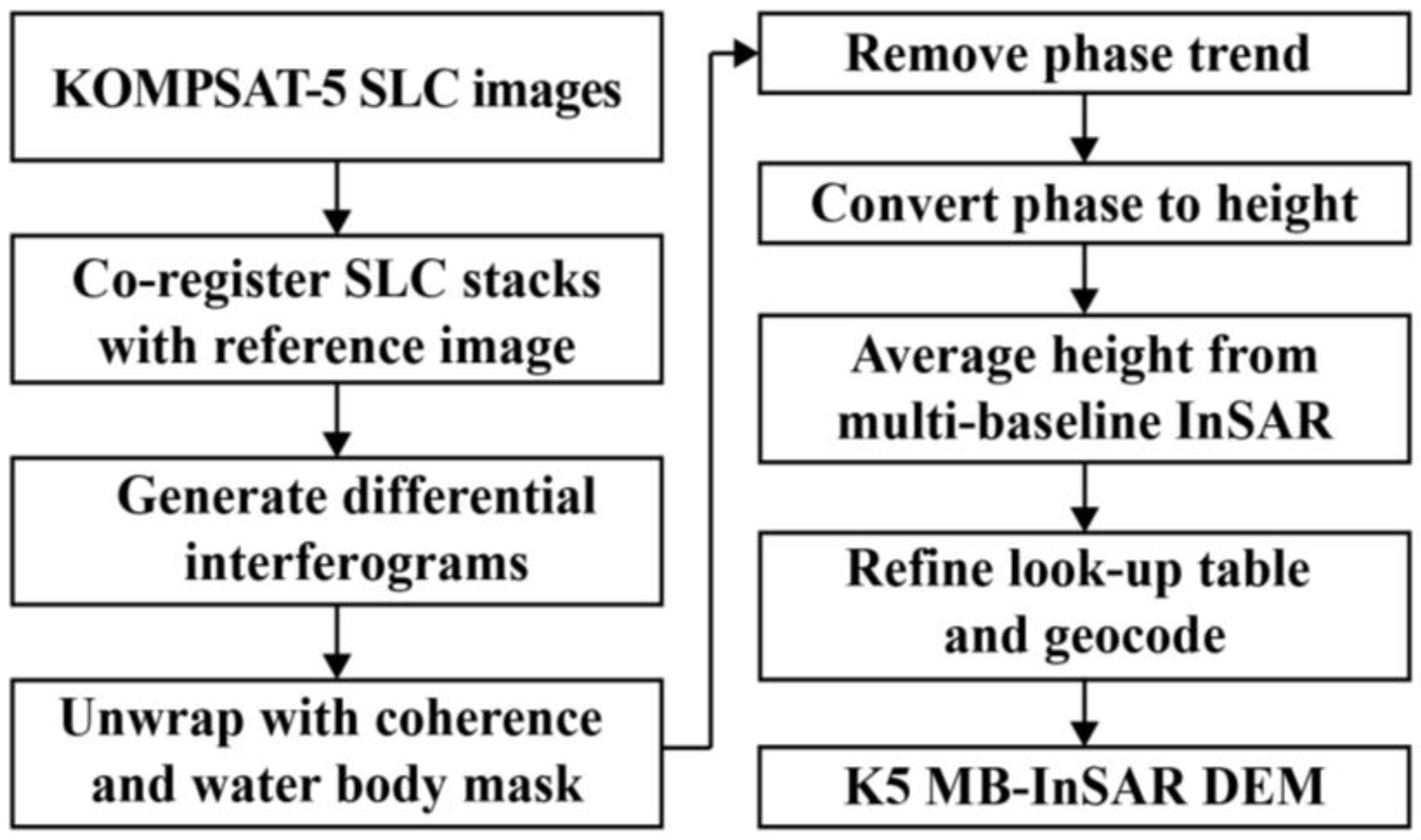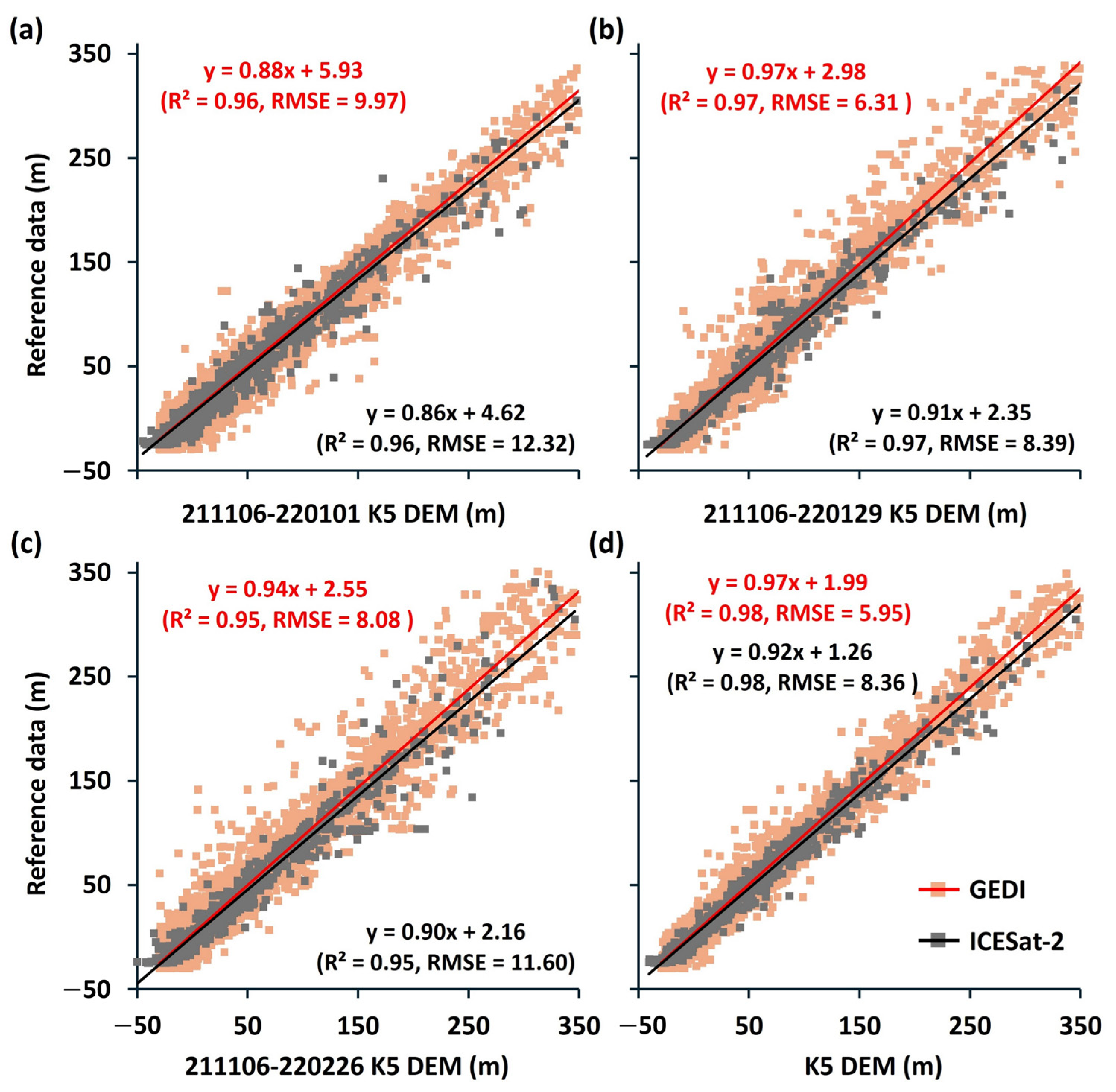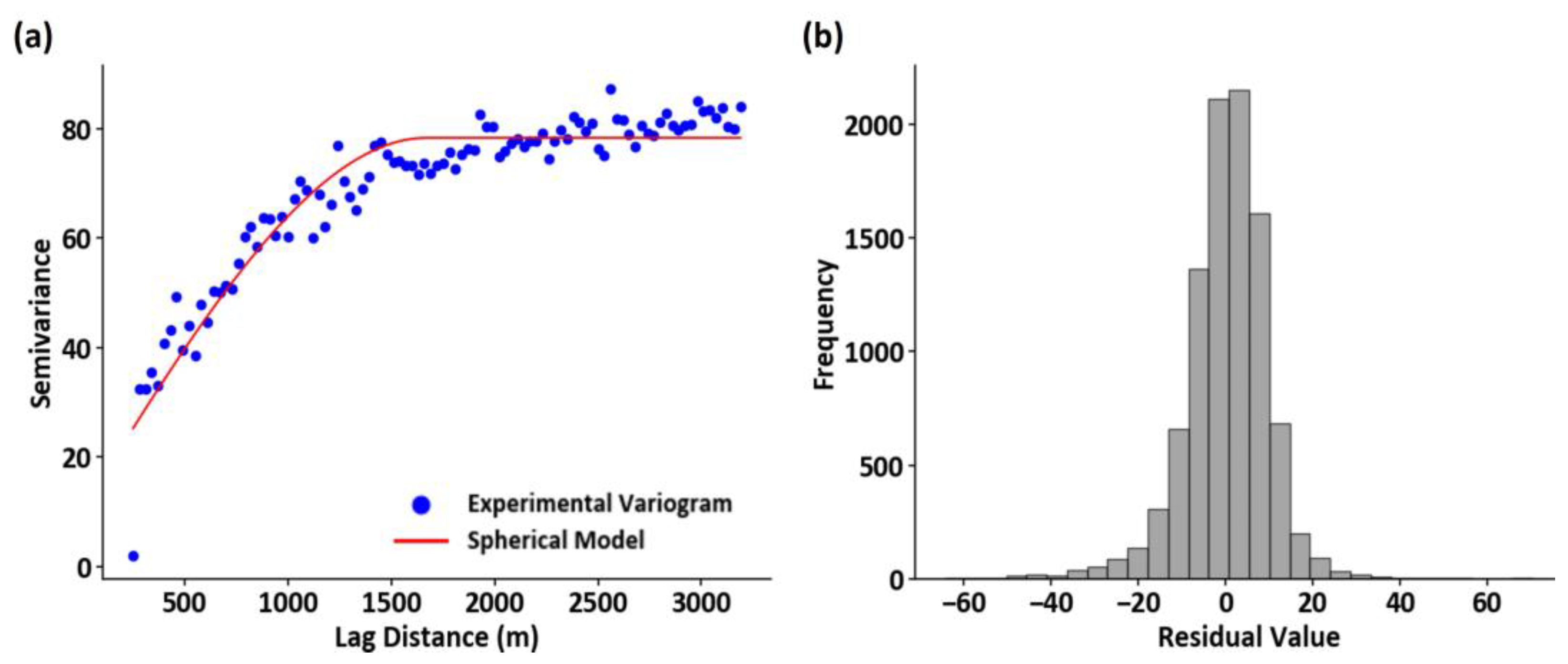Accuracy Assessment of a Digital Elevation Model Constructed Using the KOMPSAT-5 Dataset
Abstract
1. Introduction
2. Materials
2.1. Study Area
2.2. Datasets
3. Methodology
4. Results
5. Conclusions
Author Contributions
Funding
Acknowledgments
Conflicts of Interest
References
- Zhang, W.; Montgomery, D.R. Digital elevation model grid size, landscape representation, and hydrologic simulations. Water Resour. Res. 1994, 30, 1019–1028. [Google Scholar] [CrossRef]
- Rishikeshan, C.; Katiyar, S.; Mahesh, V.V. Detailed evaluation of DEM interpolation methods in GIS using DGPS data. In Proceedings of the 2014 International Conference on Computational Intelligence and Communication Networks, Bhopal, India, 14–16 November 2014; pp. 666–671. [Google Scholar]
- Luo, Y.; Ma, H.; Zhou, L. DEM retrieval from airborne LiDAR point clouds in mountain areas via deep neural networks. IEEE Geosci. Remote Sens. Lett. 2017, 14, 1770–1774. [Google Scholar] [CrossRef]
- Moreira, A.; Prats-Iraola, P.; Younis, M.; Krieger, G.; Hajnsek, I.; Papathanassiou, K.P. A tutorial on synthetic aperture radar. IEEE Geosci. Remote Sens. Mag. 2013, 1, 6–43. [Google Scholar] [CrossRef]
- Rosen, P.A.; Hensley, S.; Joughin, I.R.; Li, F.K.; Madsen, S.N.; Rodriguez, E.; Goldstein, R.M. Synthetic aperture radar interferometry. Proc. IEEE 2000, 88, 333–382. [Google Scholar] [CrossRef]
- Lei, Y.; Siqueira, P.; Treuhaft, R. A physical scattering model of repeat-pass InSAR correlation for vegetation. Waves Random Complex. Media 2017, 27, 129–152. [Google Scholar] [CrossRef]
- Rodriguez, E.; Morris, C.S.; Belz, J.E. A global assessment of the SRTM performance. Photogramm. Eng. Remote Sens. 2006, 72, 249–260. [Google Scholar] [CrossRef]
- Zink, M.; Moreira, A.; Hajnsek, I.; Rizzoli, P.; Bachmann, M.; Kahle, R.; Fritz, T.; Huber, M.; Krieger, G.; Lachaise, M. TanDEM-X: 10 years of formation flying bistatic SAR interferometry. IEEE J. Sel. Top. Appl. Earth Obs. Remote Sens. 2021, 14, 3546–3565. [Google Scholar] [CrossRef]
- Lee, H. Application of KOMPSAT-5 SAR Interferometry by using SNAP Software. Korean J. Remote Sens. 2017, 33, 1215–1221. [Google Scholar]
- Yang, D.; Jung, O.; Lee, D. Result of Kompsat-5 SAR Interferometry. In Proceedings of the The 36th Asian Conference on Remote Sensing, Manila, Philippines, 24–28 October 2015. [Google Scholar]
- Yang, D.; Jung, O.; Lee, D. Kompsat-5/6 SAR Interferometry. In Proceedings of the EUSAR 2016: 11th European Conference on Synthetic Aperture Radar, Hamburg, Germany, 6–9 June 2016; pp. 1–4. [Google Scholar]
- Karabörk, H.; Makineci, H.B.; Orhan, O.; Karakus, P. Accuracy assessment of DEMs derived from multiple SAR data using the InSAR technique. Arab. J. Sci. Eng. 2021, 46, 5755–5765. [Google Scholar] [CrossRef]
- Zhang, W.; Zhu, W.; Tian, X.; Zhang, Q.; Zhao, C.; Niu, Y.; Wang, C. Improved DEM reconstruction method based on multibaseline InSAR. IEEE Geosci. Remote Sens. Lett. 2021, 19, 1–5. [Google Scholar] [CrossRef]
- Oh, K.-Y.; Hwang, J.-I.; Yoo, W.-S.; Lee, K.-J. Performance Evaluation of KOMPSAT-3 Satellite DSM in Overseas Testbed Area. Korean J. Remote Sens. 2020, 36, 1615–1627. [Google Scholar]
- Lee, S.-R. Overview of KOMPSAT-5 program, mission, and system. In Proceedings of the 2010 IEEE International Geoscience and Remote Sensing Symposium, Honolulu, HI, USA, 25–30 July 2010; pp. 797–800. [Google Scholar]
- Lee, S.-G.; Lee, S.-J.; Kim, H.; Chea, T.-B.; Ryu, D. Status of the Kompsat-5 SAR Mission, Utilization and Future Plans. In Proceedings of the IGARSS 2020–2020 IEEE International Geoscience and Remote Sensing Symposium, Waikoloa, HI, USA, 26 September–2 October 2020; pp. 3552–3555. [Google Scholar]
- Fahrland, E.; Jacob, P.; Schrader, H.; Kahabka, H. Copernicus Digital Elevation Model Product Handbook; Airbus Defence and Space—Intelligence: Potsdam, Germany, 2020. [Google Scholar]
- Franks, S.; Rengarajan, R. Evaluation of Copernicus DEM and comparison to the DEM used for Landsat Collection-2 processing. Remote Sens. 2023, 15, 2509. [Google Scholar] [CrossRef]
- Han, D.; Kim, Y.J.; Jung, S.; Sim, S.; Kim, W.; Jang, E.; Im, J.; Kim, H.-C. Detection of Arctic Summer Melt Ponds Using ICESat-2 Altimetry Data. Korean J. Remote Sens. 2021, 37, 1177–1186. [Google Scholar]
- Neuenschwander, A.L.; Pitts, K.; Jelley, B.; Robbins, J.; Klotz, B.; Popescu, S.C.; Nelson, R.F.; Harding, D.; Pederson, D.; Sheridan, R. ATLAS/Icesat-2 L3A Land and Vegetation Height, Version 3; NASA National Snow and Ice Data Center Distributed Active Archive Center: Boulder, CO, USA, 2021. [Google Scholar]
- Kutchartt, E.; Pedron, M.; Pirotti, F. Assessment of canopy and ground height accuracy from GEDI LIDAR OVER steep mountain areas. ISPRS Ann. Photogramm. Remote Sens. Spat. Inf. Sci. 2022, 3, 431–438. [Google Scholar] [CrossRef]
- Werner, C.; Wegmüller, U.; Strozzi, T.; Wiesmann, A. Gamma SAR and interferometric processing software. In Proceedings of the Ers-Envisat Symposium, Gothenburg, Sweden, 16–20 October 2000; p. 1620. [Google Scholar]
- Goldstein, R.M.; Werner, C.L. Radar interferogram filtering for geophysical applications. Geophys. Res. Lett. 1998, 25, 4035–4038. [Google Scholar] [CrossRef]
- Chae, S.-H. Improvement of 2-pass DInSAR-based DEM Generation Method from TanDEM-X bistatic SAR Images. Korean J. Remote Sens. 2020, 36, 847–860. [Google Scholar]






| Acquisition Parameter | |
|---|---|
| Acquisition mode | Stripmap |
| Polarization | HH |
| Carrier frequency | X-band (9.66 GHz) |
| Incidence angle | 30.27° |
| Pulse repetition frequency | 3426.23 Hz |
| ADC sampling rate | 1543.75 MHz |
| Azimuth pixel spacing | 2.05 m |
| Range pixel spacing | 0.97 m |
| Interferometric Pairs | Temp. Baseline (days) | Perp. Baseline (m) | HoA (m) |
|---|---|---|---|
| 6 November 2021–1 January 2022 | 56 | −68.6 | −74.7 |
| 6 November 2021–29 January 2022 | 84 | −86.8 | −59.0 |
| 6 November 2021–26 February 2022 | 112 | −72.1 | −71.1 |
| 1 January 2022–29 January 2022 | 28 | −18.2 | −272.7 |
| 1 January 2022–26 February 2022 | 56 | −3.6 | −1392.2 |
| 29 January 2022–26 February 2022 | 28 | 14.7 | 339.5 |
| Interferometric Pairs | Coherence by Land Cover Type | ||
|---|---|---|---|
| Grassland | Trees | Urban | |
| 6 November 2021–1 January 2022 | 0.65 | 0.53 | 0.94 |
| 6 November 2021–29 January 2022 | 0.51 | 0.46 | 0.92 |
| 6 November 2021–26 February 2022 | 0.49 | 0.40 | 0.91 |
Disclaimer/Publisher’s Note: The statements, opinions and data contained in all publications are solely those of the individual author(s) and contributor(s) and not of MDPI and/or the editor(s). MDPI and/or the editor(s) disclaim responsibility for any injury to people or property resulting from any ideas, methods, instructions or products referred to in the content. |
© 2025 by the authors. Licensee MDPI, Basel, Switzerland. This article is an open access article distributed under the terms and conditions of the Creative Commons Attribution (CC BY) license (https://creativecommons.org/licenses/by/4.0/).
Share and Cite
Lee, J.-Y.; Hong, S.-H.; Lee, K.-J.; Won, J.-S. Accuracy Assessment of a Digital Elevation Model Constructed Using the KOMPSAT-5 Dataset. Remote Sens. 2025, 17, 826. https://doi.org/10.3390/rs17050826
Lee J-Y, Hong S-H, Lee K-J, Won J-S. Accuracy Assessment of a Digital Elevation Model Constructed Using the KOMPSAT-5 Dataset. Remote Sensing. 2025; 17(5):826. https://doi.org/10.3390/rs17050826
Chicago/Turabian StyleLee, Je-Yun, Sang-Hoon Hong, Kwang-Jae Lee, and Joong-Sun Won. 2025. "Accuracy Assessment of a Digital Elevation Model Constructed Using the KOMPSAT-5 Dataset" Remote Sensing 17, no. 5: 826. https://doi.org/10.3390/rs17050826
APA StyleLee, J.-Y., Hong, S.-H., Lee, K.-J., & Won, J.-S. (2025). Accuracy Assessment of a Digital Elevation Model Constructed Using the KOMPSAT-5 Dataset. Remote Sensing, 17(5), 826. https://doi.org/10.3390/rs17050826












